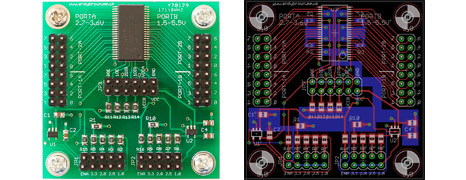In part 1 of this two part series I presented the hardware design and build for the Nokia 6300 TFT that shows how we can connect it directly to the external memory interface of the Arduino Mega and that by doing so we achieve the fastest possible interface between the TFT and the Arduino...
16 channel level converter with dual regulators
posted by Andy
If, like me, you’ve spent a lot of tinkering with things like TFT modules and other highly integrated peripherals then you’ll be familiar with the depressing section in the device datasheet that looks like this: The DC characteristics table tells you the voltages that a device expects to receive and these days it’s common for multiple voltage levels to be expected and sadly for those of us that still occasionally use the Arduino, 5V (TTL) level tolerance is becoming rarer as manufacturers switch over to ever lower CMOS voltages. Even though I mostly use the STM32 3.3V ARM MCU it’s still quite common to see a...


